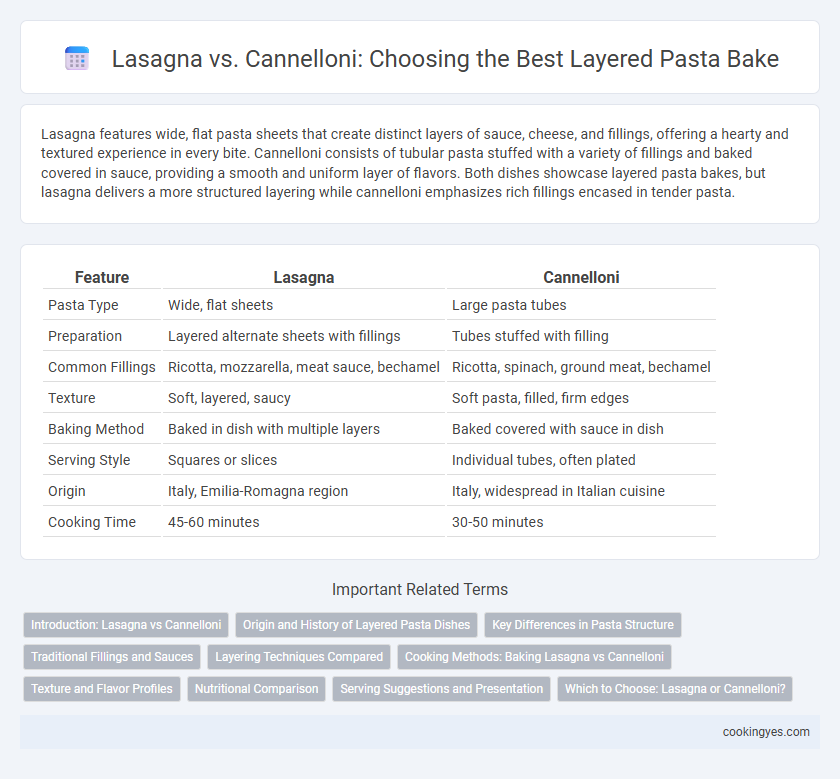Lasagna features wide, flat pasta sheets that create distinct layers of sauce, cheese, and fillings, offering a hearty and textured experience in every bite. Cannelloni consists of tubular pasta stuffed with a variety of fillings and baked covered in sauce, providing a smooth and uniform layer of flavors. Both dishes showcase layered pasta bakes, but lasagna delivers a more structured layering while cannelloni emphasizes rich fillings encased in tender pasta.
Table of Comparison
| Feature | Lasagna | Cannelloni |
|---|---|---|
| Pasta Type | Wide, flat sheets | Large pasta tubes |
| Preparation | Layered alternate sheets with fillings | Tubes stuffed with filling |
| Common Fillings | Ricotta, mozzarella, meat sauce, bechamel | Ricotta, spinach, ground meat, bechamel |
| Texture | Soft, layered, saucy | Soft pasta, filled, firm edges |
| Baking Method | Baked in dish with multiple layers | Baked covered with sauce in dish |
| Serving Style | Squares or slices | Individual tubes, often plated |
| Origin | Italy, Emilia-Romagna region | Italy, widespread in Italian cuisine |
| Cooking Time | 45-60 minutes | 30-50 minutes |
Introduction: Lasagna vs Cannelloni
Lasagna and cannelloni represent two classic choices for layered pasta bakes, each offering distinct textures and filling possibilities. Lasagna features wide, flat sheets that create multiple layers of pasta, sauce, and cheese, allowing for a balanced distribution of ingredients in every bite. Cannelloni consists of tube-shaped pasta filled with rich mixtures such as ricotta and spinach or minced meat, providing a more concentrated flavor experience within each individual roll.
Origin and History of Layered Pasta Dishes
Lasagna and cannelloni both hail from Italy's rich culinary history, with lasagna tracing back to Ancient Rome where layered pasta sheets were baked with meat and cheese, highlighting its status as one of the oldest known layered pasta dishes. Cannelloni emerged later in the Emilia-Romagna region, originally featuring tubular pasta sheets stuffed and rolled to create individual servings, distinguishing its preparation and presentation from the flat, layered structure of lasagna. Both dishes showcase the evolution of Italian pasta through regional adaptations and innovation in layering ingredients for baked casseroles.
Key Differences in Pasta Structure
Lasagna sheets are wide, flat, and thin, designed for layering with sauces and fillings to create distinct, even layers in baked dishes. Cannelloni are tubular pasta, hollow and thick-walled, intended to be stuffed and then baked, offering a filled pasta experience rather than layered. The structural difference influences baking time and sauce absorption, with lasagna providing more surface area for sauce layering and cannelloni delivering concentrated flavors inside each tube.
Traditional Fillings and Sauces
Lasagna traditionally features layers of wide, flat pasta sheets filled with a rich mixture of ricotta, mozzarella, ground beef or Italian sausage, and spinach, complemented by a robust marinara or bechamel sauce. Cannelloni is typically stuffed with a creamy ricotta and spinach filling or minced meat, then covered with a melted mozzarella topping and smothered in bechamel or tomato-based sauce. Both dishes emphasize layered textures but vary in their fillings and sauce applications, highlighting regional Italian culinary traditions.
Layering Techniques Compared
Lasagna features wide, flat sheets that create distinct, evenly spaced layers allowing sauces and fillings to meld uniformly, enhancing texture contrast in every bite. Cannelloni uses tubular pasta, where fillings are enclosed within, resulting in concentrated bursts of flavor surrounded by smooth pasta and sauce layers. Layering lasagna promotes balanced moisture distribution, while cannelloni emphasizes individual filled pockets, making each bite a layered pasta experience with different structural dynamics.
Cooking Methods: Baking Lasagna vs Cannelloni
Lasagna is prepared by layering broad flat sheets of pasta with sauce, cheese, and fillings before baking, which allows the flavors to meld evenly through gradual heat exposure. Cannelloni requires filling tubular pasta shells before arranging them in the baking dish and covering with sauce and cheese, resulting in a more structured, individual portion texture after baking. Both methods use oven baking at moderate temperatures (typically 350-375degF) for 30-45 minutes to achieve a bubbly, golden top and thoroughly cooked pasta.
Texture and Flavor Profiles
Lasagna offers broad, flat sheets that create a layered texture with a balanced chewiness, perfectly absorbing rich tomato and bechamel sauces for a deep, savory flavor. Cannelloni provides a tender, tubular shape that encases creamy ricotta and spinach or meat fillings, delivering a soft, melt-in-the-mouth bite with concentrated taste bursts. Both pasta types excel in layered bakes, with lasagna favored for its structured layering and cannelloni prized for its creamy, hearty filling experience.
Nutritional Comparison
Lasagna and cannelloni are popular choices for layered pasta bakes with distinct nutritional profiles. Lasagna sheets generally offer higher fiber content due to their wide, flat structure, while cannelloni tubes often contain more protein when stuffed with ingredients like ricotta and spinach. Both dishes vary in calories and fat depending on the fillings and cheeses used, but lasagna usually has slightly more carbohydrates per serving because of the increased pasta layers.
Serving Suggestions and Presentation
Lasagna offers a visually striking presentation with its distinct, even layers of pasta, sauce, cheese, and fillings, making it ideal for elegant plating at dinner parties. Cannelloni's tubular shape allows for versatile stuffing options and individual servings, perfect for portion control and casual dining settings. Both dishes pair well with a fresh green salad and a glass of robust red wine, enhancing the layered pasta bake experience.
Which to Choose: Lasagna or Cannelloni?
Lasagna offers broad, flat sheets ideal for creating multiple textured layers with bechamel and rich ragu, enhancing complexity in pasta bakes. Cannelloni, with its tubular shape, allows for generous fillings like ricotta, spinach, or meat, providing a hearty, individual serving experience. Choose lasagna for traditional, layered depth and cannelloni for stuffed pasta precision and portion control in layered pasta dishes.
Lasagna vs cannelloni for layered pasta bakes Infographic

 cookingyes.com
cookingyes.com